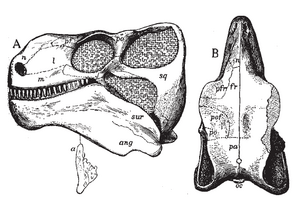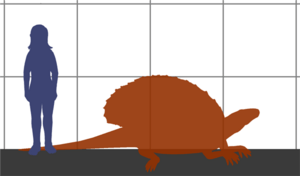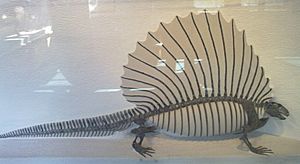Edaphosaurus facts for kids
Quick facts for kids EdaphosaurusTemporal range: Upper Carboniferous to Lower Permian, 300–280 mya
|
|
|---|---|
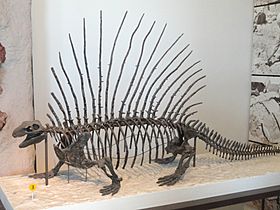 |
|
| Edaphosaurus at AMNH | |
| Scientific classification | |
| Kingdom: | |
| Phylum: | |
| Subphylum: | |
| Class: | |
| Order: | |
| Family: |
Edaphosauridae
|
| Genus: |
Edaphosaurus
Cope, 1882
|
Edaphosaurus was an ancient reptile-like animal that lived about 300 to 280 million years ago. It was a type of pelycosaur, which are early relatives of mammals. This plant-eating creature lived during the late Carboniferous and early Permian periods.
Edaphosaurus was related to the more famous Dimetrodon. Both had a large, tall sail on their backs. This sail might have helped them control their body temperature. Scientists have found fossils of Edaphosaurus in places like Europe and North America.
These creatures could be quite large, ranging from about 0.5 meters (1.6 feet) to almost 3.5 meters (11.5 feet) long. Some weighed over 300 kilograms (660 pounds)! Edaphosaurus was a bit taller and stockier than Dimetrodon. Like other pelycosaurs, it had a small head and a long tail.
Contents
What did Edaphosaurus look like?
Edaphosaurus was a sturdy animal. Its body was built for eating plants. It had a small head, but its body was quite big. Its neck bones were short, and its back bones were very strong. The tail was long and deep, and its legs were short and powerful. Its ribs formed a wide chest, suggesting it had a large stomach.
Like most plant-eaters, Edaphosaurus likely had a big gut. This helped it digest tough plant material. It probably had special bacteria inside to break down the plants.
The Sail on its Back
One of the most interesting features of Edaphosaurus was the large, sail-like fin on its back. This sail was supported by very long bones that grew from its spine. These bones were connected by skin and other tissues.
The sail of Edaphosaurus was different from Dimetrodons sail. Edaphosauruss sail had many small cross-bars on the spines. These cross-bars made its sail look a bit like a ship's mast with yardarms.
Scientists believe that Edaphosaurus and Dimetrodon developed their sails separately. This is a cool example of parallel evolution, where different animals develop similar features.
What was the sail for? Scientists are still debating this! Some ideas include:
- Helping to control body temperature.
- Providing camouflage.
- Giving extra support to its muscles.
- Protecting it from predators.
- Storing fat.
- Attracting mates or recognizing other Edaphosaurus.
The height and shape of the sail, and the cross-bars, were different in each species of Edaphosaurus. Over time, the sails became larger and more detailed. Some early ideas suggested the cross-bars might have held fat, like a camel's hump. Others thought they helped with cooling. More recent studies suggest the sail was mostly for showing off or recognizing its own kind.
Its Unique Skull and Teeth
The head of Edaphosaurus was quite small compared to its body. It was short, wide, and shaped like a triangle. Its lower jaw was very strong, with powerful muscles. The teeth along the front and sides of its jaws had jagged edges. These teeth were perfect for biting off pieces of tough plants.
What made Edaphosaurus's mouth truly special were the "pavement" teeth. On the roof of its mouth and inside its lower jaw, it had many dense, peg-like teeth. These formed wide, flat surfaces for crushing and grinding food. Its jaws moved in a front-to-back motion, helping it grind its food.
At first, some scientists thought Edaphosaurus ate soft-bodied animals like snails. But now, most paleontologists agree that it was a plant-eater. Even with its powerful grinding teeth, it seems Edaphosaurus didn't chew its food as much as some other early plant-eaters. Interestingly, some early relatives of Edaphosaurus like Ianthasaurus didn't have these special tooth plates and ate insects instead.
Types of Edaphosaurus
Scientists have found several different species of Edaphosaurus. Each species has slight differences in its size, sail, or teeth. Here are some of the known species:
How was Edaphosaurus discovered?

The first Edaphosaurus fossils were found in Texas. Edward Drinker Cope, a famous paleontologist, named and described Edaphosaurus in 1882. He called it "pavement lizard" because of its unique "dense body of teeth" that looked like a dental pavement. The first species he named was Edaphosaurus pogonias, which means "bearded" in Greek. This name referred to a chin-like feature on its lower jaw.
When Cope first described Edaphosaurus, he only had a crushed skull and a jaw. He didn't know about its large sail. At that time, only Dimetrodon was known to have such a sail.
Later, in 1886, Cope found other fossils that had long spines with cross-bars. He thought these belonged to a new animal and named it Naosaurus, meaning "ship lizard." He even thought the cross-bars might have supported a sail for navigating water! He believed Naosaurus was a meat-eater, like Dimetrodon.
However, in the early 1900s, scientists started to put the pieces together. In 1907, paleontologist Ermine Cowles Case suggested that the skull of Edaphosaurus might belong with the Naosaurus skeletons. Then, in 1913, a more complete fossil was found in New Mexico. This fossil had a Naosaurus-type skeleton with a small Edaphosaurus-type skull. This proved that Naosaurus was actually the same animal as Edaphosaurus. Since Edaphosaurus was named first, that became the official name.
Later, in 1940, two paleontologists, Alfred Romer and Llewellyn Ivor Price, named a new species, Edaphosaurus boanerges. Its name means "thunderous orator," which was a funny name for a creature with such a small jaw! In 1979, David Berman named Edaphosaurus colohistion, an early species with a smaller sail.
Edaphosaurus in popular culture
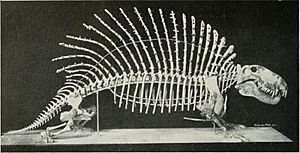
Edaphosaurus has appeared in various places, sometimes with a bit of confusion!
- Early paleoartist Charles R. Knight once drew Edaphosaurus (calling it "Naosaurus") with a Dimetrodon skull by mistake. He later corrected his painting.
- In 1907, a skeleton of "Naosaurus" was put on display at the American Museum of Natural History. This skeleton also had a Dimetrodon skull and wrong limbs. By the 1940s, the museum updated the display to show a more accurate Edaphosaurus.
- Artist Rudolph Zallinger included Edaphosaurus in his famous The Age of Reptiles mural (1943-1947) at the Yale Peabody Museum. This mural helped many people learn about prehistoric life.
- Edaphosaurus also appeared in episode 2 of the BBC documentary Walking with Monsters. In the show, a herd of Edaphosaurus was shown being attacked by a female Dimetrodon.
Images for kids
-
E. pogonias mount at the Field Museum
See also
 In Spanish: Edaphosaurus para niños
In Spanish: Edaphosaurus para niños


